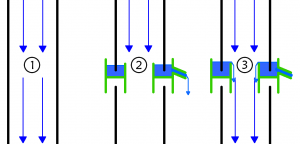With talk of water charges coming in next year, now is the time to be investigating options for reducing water usage, and harvesting rainwater and grey water. We’ve not figured out an ideal solution for the grey water yet (all our water-using appliances are at ground level, so we can’t divert to anywhere gravity can help us reuse the water), and the small people are cancelling out most of our water usage reduction measures, but when it comes to rainwater harvesting, we have a nice solution that’s working well.
A few years back, I picked up a 100L water butt and a diverter kit, and we hooked it up to the main downpipe at the back of the house. One decent rainfall had it filled, showers kept it topped up, and for about 2 years thereafter we didn’t have to take water from the kitchen tap once to water any plant inside or outside the house. Then we had a bit of a drought, so the veggies got tap water and the flowers were left to wilt. Given how well we’d gotten on with butt number 1, we decided to put a gutter and downpipe on the shed and to collect runoff from that roof too, so a second butt was installed. After a decent rainfall, both are full to the brim, and we can keep the garden lush for a couple of weeks of drought at least before we need to consider resorting to the inside tap.
I bought all the parts for the first setup separately, so it cost a fair amount, but by the time we were setting up the second butt, Argos were doing a complete kit for a much lower price, and at the time of writing, it’s on sale at a lower price again, so if you’re considering getting a butt of your own, go grab one quick!
I’m particularly impressed by the diverter component of the system. It’s a nifty little bit of engineering.
To install it, you slice your downpipe in two horizontally, then stick the diverter between the two halves. A ring-shaped “moat” sits between the two halves of the downpipe, with an outlet that can be connected to a short hose to join the diverter to a water butt. The outside wall of the moat is taller than the inside wall, so when it fills, it overflows back down the inside of the drainpipe.

- Without a diverter (1), rain just gets washed straight down the downpipe and into the drain.
- With a diverter connected to an empty water butt (2), rain pools in the moat and flows off into the connected butt.
- When the butt is full (3), collected rain can’t exit via the diverter hose anymore, so pools till it overflows the moat on the inside of the downpipe and flows to the drain as usual.
For a relatively small investment, you’re set up with a reservoir that should amply water a small garden year round, and provide untreated water suitable for jobs such as scrubbing down a patio, and rinsing dirty wellies and garden tools. For larger gardens, you can source larger butts from garden centres and specialist suppliers, or do what we do and dot a few different smaller butts around the garden so that you have a ready water supply in multiple locations.

